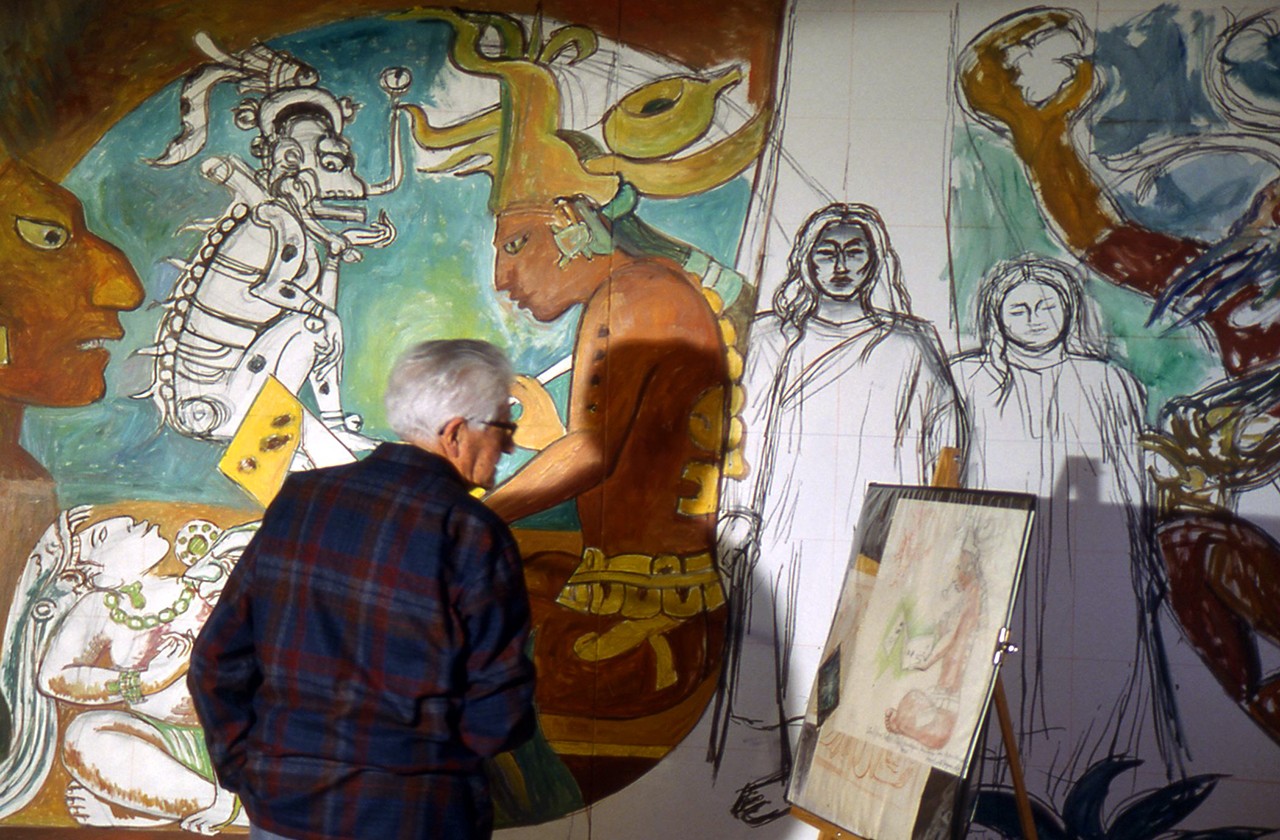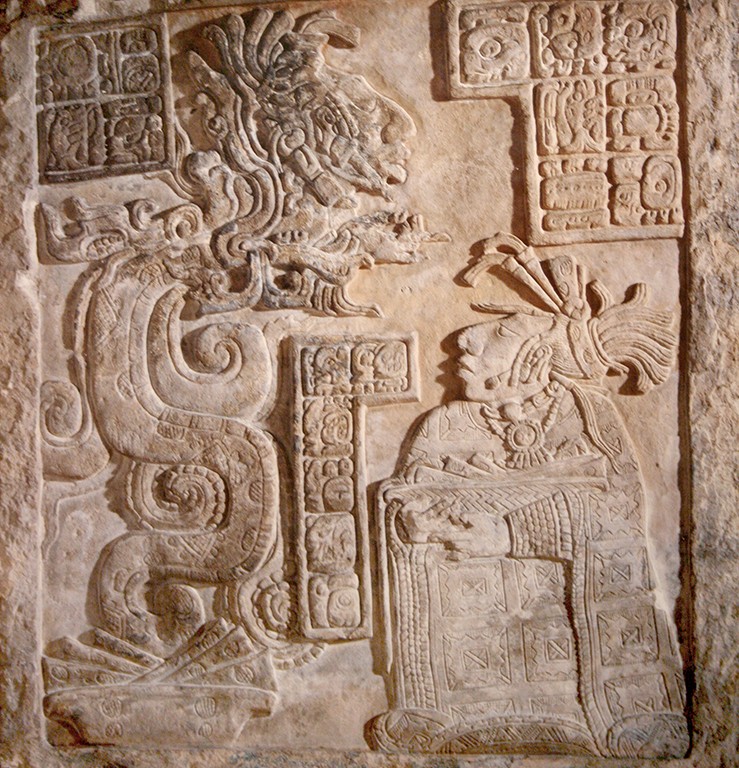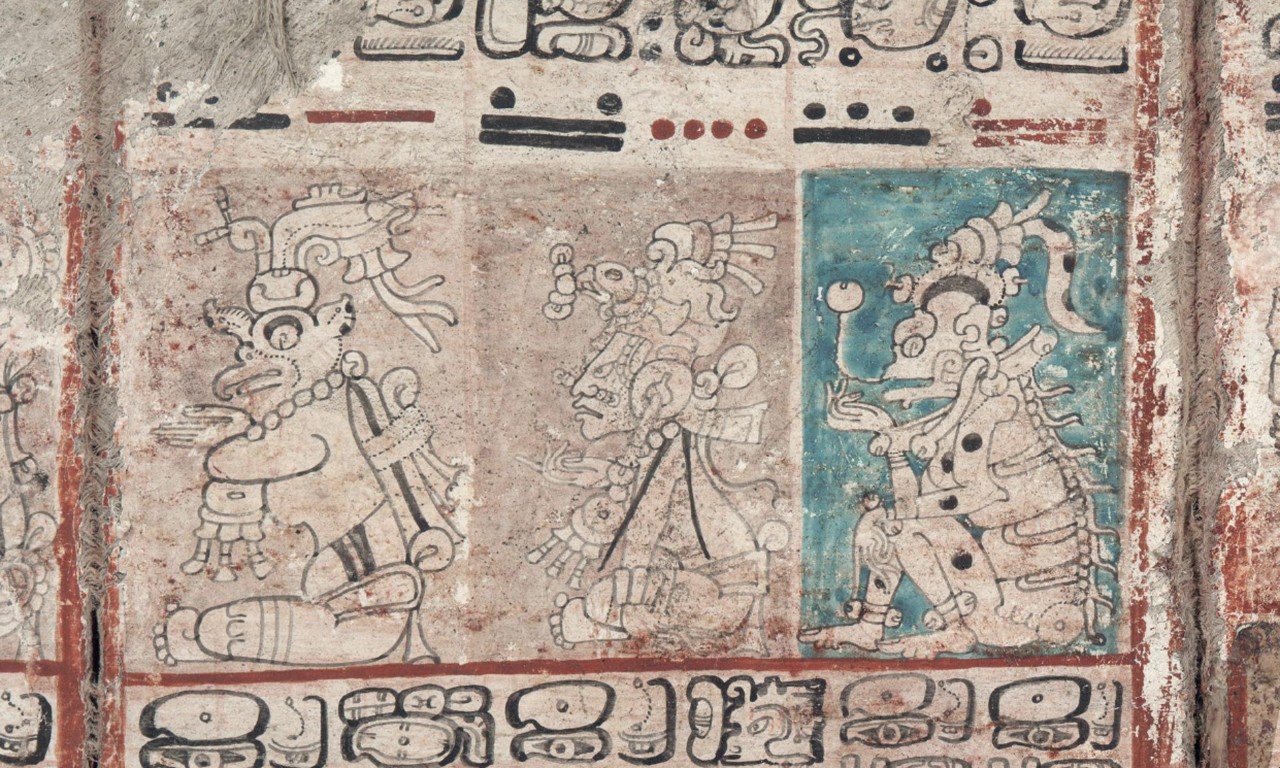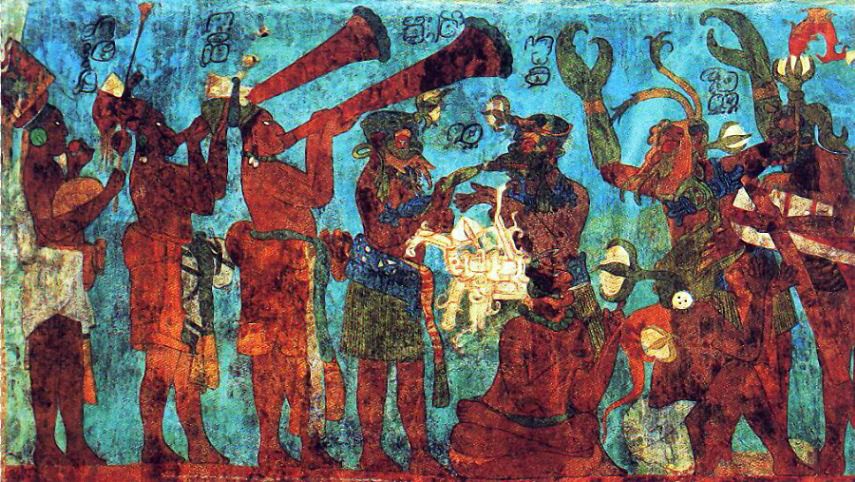 |
The Mayas, c.1999
Raúl Anguiano (Mexican, 1915-2006)
Oil on canvas
99.63.2
Gift of Bowers Museum Collectors Council |
National Hispanic Heritage Month
September 15 to October 15 is National Hispanic Heritage Month, an opportunity to celebrate the achievements of Hispanic Americans. This year, the Bowers Blog looks at Raúl Anguiano (Mexican, 1915-2006) and his mural-sized The Mayas, one of two paintings created onsite at the Bowers Museum by the prolific Mexican artist in 1999. Though this post was originally published in 2007, this re-publication offers new insight into the iconography of The Mayas and dives deeper into its source material.
 |
| Raúl Angiano painting The Mayas at the Bowers Museum, 1999 |
Anguiano’s Journey
Raúl Anguiano led a prestigious artistic career that took him around the world and his paintings, drawings, and murals into some of the world’s most prominent museums. Born in Guadalajara, Mexico on February 26, 1915, Anguiano began studying art at a young age. At fifteen he joined Bandera de Provincias, a group of artists that expanded his artistic, political, and literary knowledge. Shortly thereafter he moved to Mexico City where he was witness to the highly charged political atmosphere and the equally revolutionary developments in painting by artists such as Siqueiros and Rivera. He became a founding member of the famed Taller De Gráfica Popular in 1937; an organization that promoted social and political causes in Mexico City. Anguiano’s art made him a representative of Mexico—not the least of which was the country’s Indigenous peoples.
99.63.2 with key elements cut out
Gift of Bowers Museum Collectors Council |
Cast of Characters
The Mayas is a two-panel painting that seeks to holistically capture the essence of the Maya people; it depicts both age-old dieties of the Mayan pantheon and modern-day Mayan peoples. Much of the inspiration for this work came from a 1949 anthropological and archaeological expedition to study the Lacandon Maya, a population living in the rainforests of Chiapas along the Usumacinta River. Most of the source material comes from three sites in the region: Yaxchilan, Bonampak, and Palenque, but the scope of the work stretches beyond Anguiano’s personal experience, pulling in the relief work on architectural pieces that had been taken out of Mexico decades before his expedition and the Dresden Codex, perhaps the single most important primary resource on Mayan culture and their belief system. For Anguiano, the subject matter of this painting was one with which he was intimately familiar.
Below we break down the painting into eight key elements and briefly outline what each of these represent and, if known, what the reference was for the image:
 |
| Yaxchilan lintel 15 featuring Lady Wak Tuun, during a bloodletting rite. |
-
On the far left of the painting is a Vision Serpent which Anguiano included as a representation of Kukulkán, the Feathered Serpent and principal Mayan deity. On the source that Anguiano used—a stone lintel that was removed from the ancient Mayan city of Yaxchilan in the 19th century—the feathered serpent is a vehicle for a royal named Lady Wak Tuun to commune with a deceased ancestor.
-
In the lower left-hand corner of the mural is a family of Kinkajou, an adorable animal that is native to the forest regions of the Lacandon Maya. In Spanish the animal is colloquially called el mico de noche (nocturnal monkey).
-
The large figure in profile is either a priest or a warrior and comes from the beautiful polychrome frescos in the Mayan ruin of Bonampak, a Classic Period site in eastern Chiapas, Mexico which flourished between 450-800 CE. The Bonampak murals are located in the three-room Temple of the Paintings, which is covered floor to ceiling with scenes of Mayan upper-class life: battles, meetings of dignitaries, celebrations with dancers, musicians, and scenarios depicting human sacrifice.
-
This seated figure with an anthropomorphized reptile on his lap was originally a glyph from Palenque’s palace building. It was recorded by Anguiano during his examination of this site in 1954. Palenque is a Classic Maya center found in the foothills of the Chiapas Mountains, from which it overlooks the Tabasco plain. The most celebrated ruler of Palenque was Lord Pacal whose famous tomb cover was reproduced for the Bowers’ Vision of the Shaman, Song of the Priest exhibition.
 |
| Detail of page 11 of the Dresden Codex featured Ah Puch on the right. |
-
The God of Death, Ah Puch, is easily recognizable due to its skeletal form. Anguiano’s incorporation of the figure in the mural was inspired by its depiction in the Dresden Codex. Ah Puch presided over the lowest of the nine Maya underworlds and was closely allied with the god of war and human sacrifice.
-
In the center of the The Mayas a scribe writes the history of his people. According to interviews with Anguiano, the scribe is Hunahpu, one of the main heroes of Mayan lore, and the book is the Dresden Codex.
-
During Anguiano’s expedition to Chiapas, he met and befriended a Lacandon couple named Chambor and Na-kin. It was important to Anguiano that the story of the Maya include the approximately seven million Mayan people that still live on their ancestral lands in Central America.
 |
| Detail of the Bonampak mural with the dancers that Anguiano uses as a reference on the right. |
-
The last element in the composition is inspired by and taken from another fragment of the fresco murals found at Bonampak. In spite of their otherwordly appearance, it is a group of dancers and musicians disguised as animals: crawfish, alligators, and more.
Text and images may be under copyright. Please contact Collection Department for permission to use. References are available on request. Information subject to change upon further research.






Comments